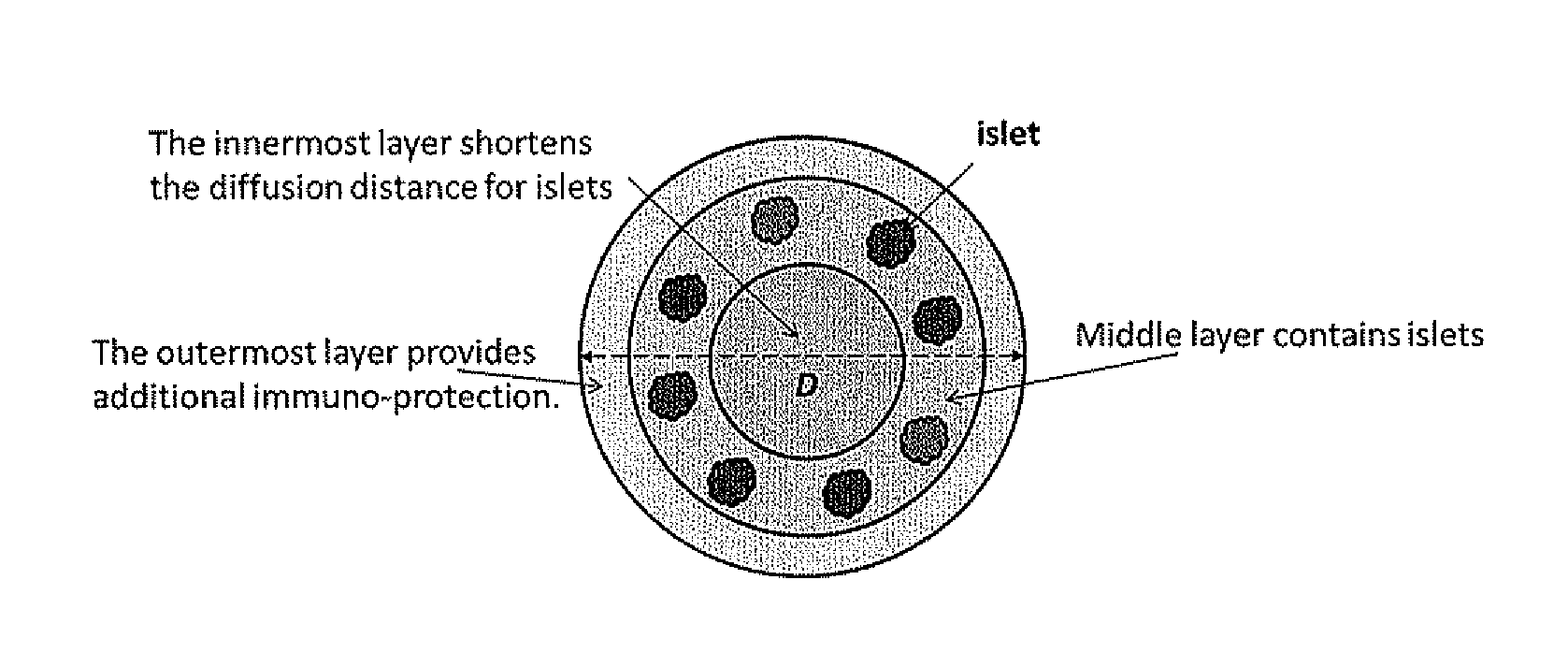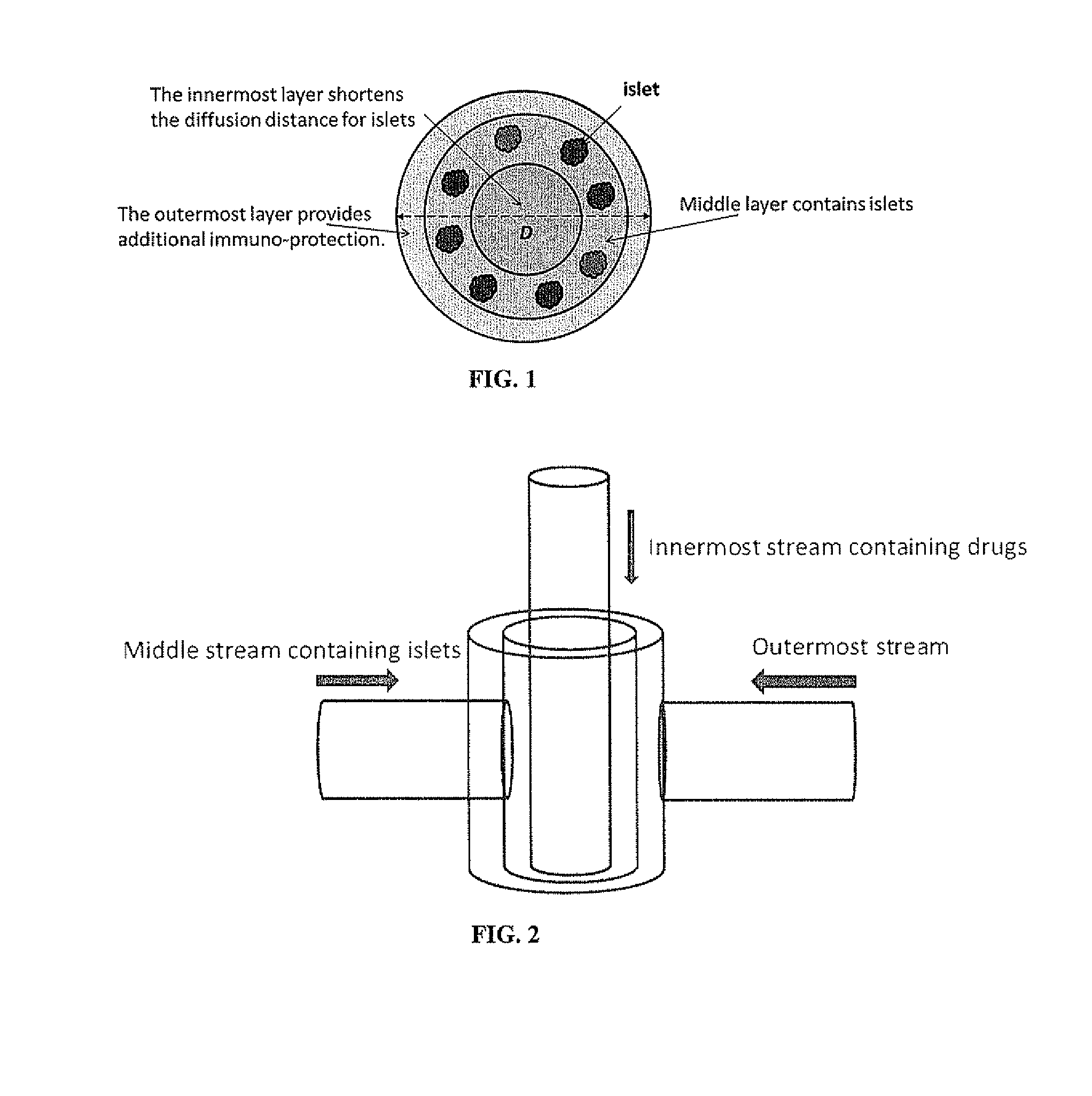Multi-Layer Hydrogel Capsules for Encapsulation of Cells and Cell Aggregates
a multi-layer hydrogel and cell aggregate technology, applied in the field of cell encapsulation, can solve the problems of inadequate immune protection, lack of control of the relative position of the cells within the capsule, and additional challenges to advance the system
- Summary
- Abstract
- Description
- Claims
- Application Information
AI Technical Summary
Benefits of technology
Problems solved by technology
Method used
Image
Examples
example 1
Preparation of Core-Shell Alginate Based Microcapsules
[0129]Materials and Methods
[0130]Design of Core-Shell Nozzle and Formation of Core-Shell Capsules:
[0131]A type of alginate-based hydrogel microcapsules with core-shell structures using a two-fluid co-axial electro-jetting that is compatible with the current alginate-based cell encapsulation protocols was developed. The composition and thickness of the core and shell can be independently designed and controlled for many types of biomedical applications. FIGS. 3A and 3B are schematic depictions of a conventional cell encapsulation approach (FIG. 3A) and a two-fluid co-axial electro-jetting for core-shell capsules and cell encapsulation (FIG. 3B). FIG. 3B shows a schematic of the two-fluid co-axial electro-jetting for the fabrication of core-shell capsules and encapsulation of cells or cell aggregates. This two-fluid configuration was used to make core-shell hydrogel capsules and encapsulate living cells.
[0132]The shell fluid consis...
example 2
Preparation of Large Two-Layer Hydrogel Capsules (>1 mm) for Encapsulation of Therapeutic Cells and Cell Aggregates
[0152]Materials and Methods
[0153]The method of encapsulation includes two general steps: (a) forming droplets of alginate solution containing islets and (b) conversion of the droplets into hydrogel capsules. Mechanical or electrostatic forces can be used to control the droplet or capsule sizes. The islets can be randomly distributed within the capsules. The islets can also be introduced in the shell region of the capsules to facilitate the mass transfer. This can be achieved by using a two-fluid encapsulation approach where one stream of alginate solutions containing islets serves as the shell fluid and a separate stream of cell-free alginate solution flows in the core. Additional components such as an anti-inflammatory drug can also be incorporated into the core.
[0154]Two types of large (D>1 mm) alginate hydrogel capsules for islets encapsulation were prepared. In the ...
PUM
| Property | Measurement | Unit |
|---|---|---|
| Diameter | aaaaa | aaaaa |
| Diameter | aaaaa | aaaaa |
| Diameter | aaaaa | aaaaa |
Abstract
Description
Claims
Application Information
 Login to View More
Login to View More - R&D
- Intellectual Property
- Life Sciences
- Materials
- Tech Scout
- Unparalleled Data Quality
- Higher Quality Content
- 60% Fewer Hallucinations
Browse by: Latest US Patents, China's latest patents, Technical Efficacy Thesaurus, Application Domain, Technology Topic, Popular Technical Reports.
© 2025 PatSnap. All rights reserved.Legal|Privacy policy|Modern Slavery Act Transparency Statement|Sitemap|About US| Contact US: help@patsnap.com



